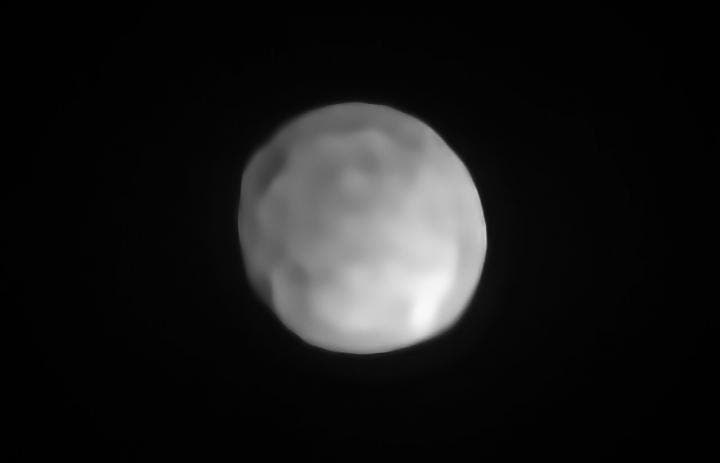The European Space Observatory’s SPHERE instrument has spotted what may be the smallest small planet in our solar system.

Image credits ESO/P. Vernazza et al. / MISTRAL algorithm (ONERA/CNRS).
The object christened Hygiea is currently considered an asteroid — but it might be classified as a dwarf planet. It’s the fourth largest body in the asteroid belt after Ceres, Vesta, and Pallas. The reclassification follows on the heels of new observations: for the first time, astronomers were able to look at Hygiea with a sufficiently-high resolution to study its surface and to determine that it is spherical (a condition necessary to be considered a planet).
Hygiea might thus officially become the smallest dwarf planet in our solar system — a title currently held by Ceres,
Small but significant
“Thanks to the unique capability of the SPHERE instrument on the VLT (Very Large Telescope), which is one of the most powerful imaging systems in the world, we could resolve Hygiea’s shape, which turns out to be nearly spherical,” says lead researcher Pierre Vernazza from the Laboratoire d’Astrophysique de Marseille in France.
“Thanks to these images, Hygiea may be reclassified as a dwarf planet, so far the smallest in the Solar System.”
Prior to this discovery, we already knew that Hygiea satisfied three of the four requirements to be considered a dwarf planet: it orbits around the Sun, it is not a moon, and it has not cleared the neighborhood around its orbit (like a proper planet would). The final requirement is for it to have enough gravitational force to pull itself into a roughly spherical shape. Thanks to new observations, we now know that Hygiea passes this criterion as well.
Based on the SPHERE data, the team estimated Hygiea’s size to be around 430 km in diameter. Ceres is closer to 950 km in diameter while Pluto, the largest dwarf planet, comes close to 2400 km.
One surprising find was that Hygiea lacks any large impact craters on its surface. The team really expected to find such a structure on its surface as Hygiea is the main member of one of the largest asteroid families (with around 7000 members) that all come from the same parent body. It was believed that Hygiea would have been left scarred by the event that led to that original body breaking apart. Although the astronomers observed Hygiea’s surface with a 95% coverage, they could only identify two relatively small craters.
“This result came as a real surprise as we were expecting the presence of a large impact basin, as is the case on Vesta,” says Vernazza.
“Neither of these two craters could have been caused by the impact that originated the Hygiea family of asteroids whose volume is comparable to that of a 100 km-sized object. They are too small,” explains study co-author Miroslav Bro of the Astronomical Institute of Charles University in Prague, Czech Republic.
Computer simulations suggest that Hygiea’s shape and the large number of members in its asteroid family were the result of a major head-on collision between the parent body and an object between 75 and 150 km in diameter around 2 billion years ago, The simulations showed that this violent impact completely shattered the parent body. Hygiea, the simulations suggest, is the product of left-over pieces that reassembled themselves into a round shape surrounded by companion asteroids.
“Such a collision between two large bodies in the asteroid belt is unique in the last 3-4 billion years,” says Pavel Ševeček, a PhD student at the Astronomical Institute of Charles University and paper co-author.
“Thanks to the VLT and the new generation adaptive-optics instrument SPHERE, we are now imaging main belt asteroids with unprecedented resolution, closing the gap between Earth-based and interplanetary mission observations,” Vernazza concludes.
The paper “A basin-free spherical shape as outcome of a giant impact on asteroid Hygiea” has been published in the journal Nature Astronomy.


